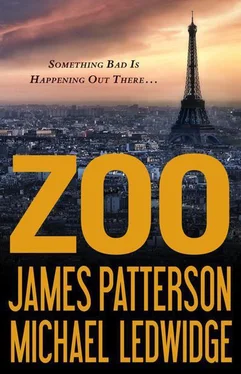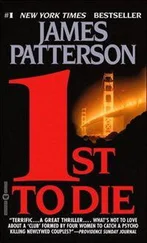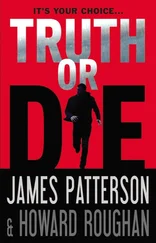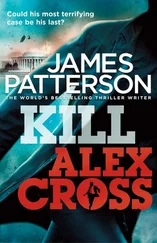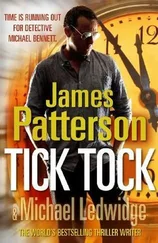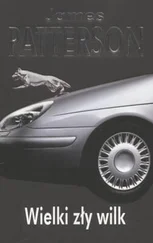“Disgusting,” said Chloe.
Then she began backing away from me, her hands flying to her face.
“ Mon Dieu! What is that smell?” she said, finally catching the full brunt of the dog sludge I’d crawled through.
“Exactly!”
I shimmied out of my shirt. My pants followed a moment later. I was leaving black streaks on the kitchen tiles. I rummaged through the kitchen drawers in my socks and underwear, found a plastic bag, and threw the clothes inside, tying it tightly.
“We need to test my clothes. It’s their smell. I think the dogs are emitting it. But they almost weren’t acting like dogs, Chloe. I know this sounds insane. They were acting like insects. Like ants or bees or something. It’s not a virus, like rabies, that’s making the animals go haywire. We need to test for some kind of new pheromone in the environment.”
“That’s crazy,” Chloe said, still covering her face.
“Is it?” I said. “This whole thing has been staring us in the face from the beginning. How do animals communicate? Subconsciously, I mean. How do dogs, bears, hyenas recognize one another, their environment, their territory?”
“Secreting and sniffing pheromones,” Chloe said.
“Life, at its most basic level, is chemistry,” I said. “Right?”
“Hmm.”
“Groups of molecular compounds reacting to other groups of molecular compounds. When an animal sniffs a rival or a predator, it receives information that changes its behavior. That’s what’s occurring here. In some way. Except the animal signals are getting crossed somehow. The signals they’re getting are making them act against their instincts. There’s something new, something wrong—either with the pheromones themselves or the way the animals are processing them.”
“It might make sense,” Chloe said, getting into it now. “The mutations we found in the animals were in the amygdala, which usually governs the sense of smell.”
I paced back and forth across the kitchen in my underwear, still holding the sagging trash bag full of my reeking clothes.
“I think it may even have something to do with that bizarre stuff that went on with Attila,” I said. “A chimp’s sense of smell isn’t that great. But I rescued him from a perfume lab where they were doing chemical experiments on him. I think the pheromone or whatever it is in the environment somehow made him go crazy.”
“Like a steroid or something,” Chloe said. “Are the animals exhibiting a kind of chemically triggered rage?”
“Could be.”
“But why all of a sudden?” Chloe said. “What’s changing the way they perceive pheromones?”
“I don’t know. But I do know that we need to find some pheromone experts and put them in a room, yesterday. More like five years ago. I’ll call the lab, you call that government guy, Leahy. I think we finally caught a break on this thing.”
THE REST OF my morning consisted of a Silkwood shower and a Jerry Lewis telethon’s worth of phone calls.
By midafternoon Chloe, Eli, and I were sitting around the kitchen table with our bags packed and ready to go. I guessed our ride was out front when my phone went bzvvvvt bzvvvvt on the table and UNKNOWN NUMBER popped up on the screen. I went to the window and looked down.
When the NSA chief, Mike Leahy, said he was sending a car to take us to a secure location, I thought he had meant, well, a car.
On the sidewalk in front of our building was a camo-colored up-armored combat Humvee, with a soldier manning a machine gun in the steel-plated turret. For traveling with a low profile, I guess.
A young kid with orange hair and freckles, straight out of Archie Comics, met us in the lobby downstairs. He saluted.
“Lieutenant Durkin, US Army Third Infantry,” he said in that military cadence, a forward tumble of barks rising in pitch.
“Jesus, is it getting this bad out there, Lieutenant?” I said, gesturing at the war machine we were apparently about to enter. Durkin hoisted our bags as though he were a valet and led us toward the Humvee.
“Manhattan below Ninety-Sixth Street is in the process of being evacuated,” he said. “We’re starting with the hospitals and hospice facilities.”
“ What? Why?”
“Rats.”
As we rolled north through Manhattan we saw barricades, checkpoints. The city was swarming with men and women in camo. The only vehicles that passed us going in the opposite direction were government evacuation buses and more army Hummers.
Times Square was empty. I glanced at the darkened marquee as we passed the Ed Sullivan Theater, where they tape Late Show with David Letterman . No stupid pet tricks tonight.
When we turned west on Fifty-Seventh Street we heard the whoosh of fire, and looked out the window to see two soldiers in silver suits kneeling in front of an open manhole, aiming flame throwers beneath the street.
We stopped on Fifth Avenue and Eighty-First Street. A chain-link fence braced with sandbags had been strung across the avenue in front of the Metropolitan Museum of Art.
The Upper East Side was occupied now? When had all this happened? And why hadn’t I heard about it? The world had flipped from normal to bizarre in what? Hours? Things had seemed fine to me that morning.
“These two blocks are HQ for the time being,” Durkin said as a guard waved us through the makeshift fence. “This kinda reminds me of the Green Zone in Baghdad.”
“Or Ground Zero after nine-eleven,” I said.
We rolled past sandbagged trailers and stacked crates of bottled water and came to a stop in front of a stately granite prewar building directly across from the Met. The building’s interior was all gilded ornaments and Corinthian columns, glass, brass, marble, potted ferns. Durkin led us into the grand lobby, where an NYPD sergeant checked our IDs and, for no discernible reason, wanded us with a metal detector—including Eli, just to make sure our three-year-old boy wasn’t packing heat.
“Who’s in charge?” I asked Durkin.
“Colonel Walters, but he’s in the field.”
“The field?”
“Well, the city. I think some of the other scientists are here. Let me show you to your quarters first.”
They were nice quarters. The apartment we were led into was a multimillion-dollar duplex with massive fireplaces and twelve-foot coffered ceilings. The living room was cluttered with marble sculptures and African masks. There was a Chagall on the dining room wall.
“Fancy digs. How’d the army sublet Xanadu?” I said to Durkin.
He shrugged.
“Ours is not to reason why,” he said. “You guys settle in. The meeting’s on the first floor at sixteen hundred hours. Enjoy your vacation at the end of the world.”
WE LEFT ELI in a makeshift day-care center that had been set up for the scientists’ children on the building’s fifth floor and went downstairs to help prepare for the meeting. I was surprised at how quickly Chloe and I adapted to all this doomsday scenario stuff. One day, you drop your kid off at pre-K, the next you take him to a government evacuation center’s day-care facility. What else could we do?
In a large alcove off the sweeping marble lobby, we worked with camo-clad army techs to convert a dining room into a conference room, complete with an interactive whiteboard. The table was a sleek, oblong, blood-colored mahogany, its surface so glossy it reflected light as sharply as a mirror. The room was huge, the ceilings fifteen feet high, with marble cornice moldings in the corners and dark oil paintings of robber barons set in the walls. A chandelier dangled like a bunch of crystal grapes above the table.
Читать дальше
